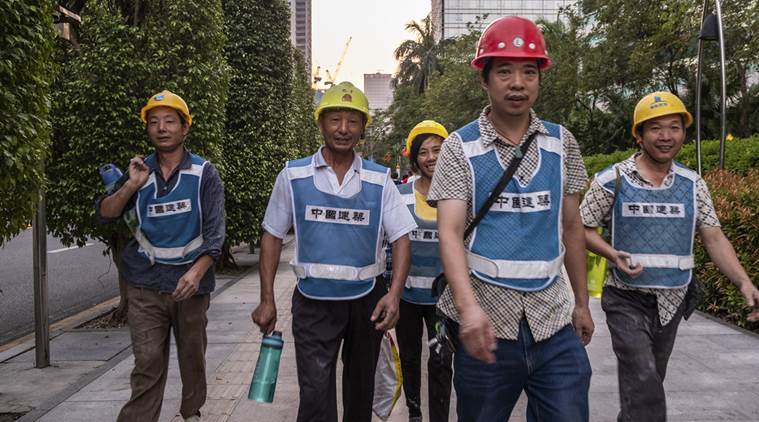As slowdown and trade war loom, China’s going to pump $175 bn into its economy
The government is aiming to help small and midsize businesses in particular, which have had trouble obtaining loans and face other rising pressures.

Construction workers after their shift in Futian, China. (The New York Times photo)
China is signaling that it is worried about its economy.
Troubled by slowing growth, persistent debt problems and President Donald Trump’s trade war, the Chinese government has taken steps in recent months to shore up its economy. It has pared back a high-profile campaign to tackle debt. It has restarted big infrastructure projects, a traditional economic engine. It has even censored bad economic news.
4m 27s

Monthly economic update with MLC, August 2018
14 Aug 2018 - MLC Senior Economist Bob Cunneen discusses the Reserve Bank's decision to put rates on hold and the latest market moves with NAB Asset Management Portfolio Specialist Sinead Rafferty.
On Sunday, Beijing went one step further.
The People’s Bank of China, the central bank, pulled a financial lever that will effectively pump $175 billion into the economy. The government is aiming to help small and midsize businesses in particular, which have had trouble obtaining loans and face other rising pressures.
The move signals that China’s economy “is really not doing well,” Chen Shouhong, the founder of the investment information platform Gelonghui, wrote on WeChat, a popular Chinese social media service.
The growing trade war with the United States has been the most visible threat. In September, the United States imposed tariffs on $200 billion in goods from China. Trump has shown little inclination to back off, and relations between the two countries have cooled, suggesting the trade war could worsen before it gets better.
So far, the trade war has had only a minor effect on China’s $12 trillion economy. Trade is not as important to China as it once was, thanks in part to the rise of a middle class that has been a ready buyer of Chinese goods at home. Still, tariffs could hurt the economy the longer they last. In September, new export orders — one indicator of China’s manufacturing — fell to the lowest level since 2016.
But China has bigger problems than the trade war.
Consumers are spending less. Retail sales this year have grown at the slowest rate in a decade. Wage growth is plodding. Infrastructure investment — a pillar of the Chinese economy — slowed significantly in the first half of the year. The pace at which companies are defaulting on their bonds has quickened.
China also has to contend with a stock market that has fallen by around 15 percent this year and a currency that has lost 10 percent of its value against the dollar. Some Chinese entrepreneurs also say the business environment is souring. The government could soon require companies to pay more in taxes and benefits.
Government officials in recent months have scurried to counter the broader economic slowdown. They pledged to pump billions of dollars into infrastructure projects, shored up the value of the currency and moved to backstop the falling stock market.
China has used these methods for years to spur growth, but they represent a retreat from more recent government efforts to pare back debt. China unleashed a wave of spending and lending beginning a decade ago that rescued its economy from the global economic downturn but left many of its companies and local governments heavily burdened with debt. Economists have warned that China must address its debt problems if it hopes to keep its economy humming.
Beijing appeared to be listening. Earlier this year Liu He, a trusted economic adviser to Xi Jinping, the country’s top leader, promised to rein in China’s debt during the next three years. Liu’s appointment in March as vice premier overseeing financial and industrial policy was seen as a commitment by Chinese officials to crack down on lending.
Now, Beijing has changed its tune. In August, the People’s Bank of China said it would ensure that money flowed from its state-controlled banking sector to companies that needed it, in particular exporters and small and medium enterprises. The National Development and Reform Commission also flagged concerns about the financing difficulties of private companies in June.
The government has promoted rail and other infrastructure projects that were previously stalled or blocked because of concerns about ballooning debt.
If it was not clear before last week that Chinese officials were concerned about a slowing economy, a move by the government on September 28 to censor negative economic news made it clear. Among the items on a list of forbidden topics on a government directive sent to journalists in China were any economic data that showed a slowing economy, local government debt and risks, and signs of declining consumer confidence.
On Sunday, the People’s Bank of China said that it would cut the amount of money that some lenders are required to hold in reserve — called the reserve ratio — by 1 percentage point. The move essentially frees up more money for China’s state-controlled banks to lend out.
About $65.5 billion of that cash injection will be directed to banks to repay debts that are due in coming weeks, while the rest will be pushed into the financial market.
The central bank made the move to ensure “reasonable and sufficient liquidity” in China’s economy, it said. This is the fourth time this year that the central bank has cut the reserve ratio.













































No hay comentarios:
Publicar un comentario